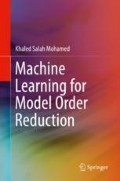Abstract
The universe consists of matter and energy as depicted in Fig. 1.1; the aim of the engineering science is to understand both and try to model and develop any system. Many physical phenomena can be described mathematically by the same class of system. Any system can be represented by a set of continuous Partial Differential Equations (PDEs) or discrete Ordinary Differential Equations (ODEs). At the same time, any set of PDEs should be transformed into a system of ODEs which can be linear ODEs or nonlinear ODEs. So, discretization is needed which approximates the behavior of the continuous systems. For example, Maxwell’s equations in electromagnetic describe the behavior of the system continuously in time and space [1]. Most CAD tools use the numerical Finite Element Method (FEM) approximation to accurately discretize in space, model and simulate these continuous structure-level VLSI systems. Solving linear ODEs results in matrix form system that can be solved using direct method such as Gaussian elimination method or indirect method (iterative methods) such as Jacobi method, and solving nonlinear ODEs can be done by Newton’s method. These methods are useful for moderately sized problems.
Access this chapter
Tax calculation will be finalised at checkout
Purchases are for personal use only
References
G. De Luca, G. Antonini, P. Benner, A Parallel, Adaptive Multi-Point Model Order Reduction Algorithm, in 22nd IEEE Conference on Electrical Performance of Electronic Packaging and Systems (EPEPS), (2013)
C. Wang , H. Yu , P. Li ,C. Ding , C. Sun , X. Guo , F. Zhang , Y. Zhou, Z. Yu, Krylov Subspace Based Model Reduction Method for Transient Simulation of Active Distribution Grid in IEEE Power and Energy Society General, Meeting (PES), PESMG, (2013)
J.R. Koza, Genetic Programming On the Programming of Computers by Means of Natural Selection, Massachusetts Institute of Technology, (1992)
S. Panda, J.S. Yadav, N.P. Patidar, C. Ardil, Evolutionary techniques for model order reduction of large scale linear systems. WASET Int. J. Elec. Comp. Energ. Elect. Com. Eng. 6(9), 1105 (2012)
S.N. Sivanandam, S. N. Deepa, A Comparative Study Using Genetic Algorithm and Particle Swarm Optimization for Lower Order System Modeling, Department of Computer Science and Engineering, PSG College of Technology
P.O. Gutman, C.F. Mannerfelt, P. Molander, Contributions to the model reduction problem. IEEE Trans. Auto. Control 27, 454–455 (1982)
E.S. Gopi, Algorithm Collections for Digital Signal Processing Applications Using Matlab (National Institute of Technology, Tiruchi)
W.H.A. Schilders, H.A. van der Vorst, J. Rommes, Model Order Reduction: Theory, Research Aspects and Applications, (2000)
P. Benner, M. Hinze, and E.J.W. ter Maten, Model Reduction for Circuit Simulation
M. Tombs, I. Postlethweite, Truncated balanced realization of a stable non-minimal state-space system. Int. J. Control 46, 1319–1330 (1987)
J.E. Schutt-Ainé, P. Goh, Comparing Fast Convolution and Model Order Reduction Methods for S-Parameter Simulation in IEEE Electrical Design of Advanced Packaging & Systems Symposium (EDAPS), (2013)
B. Vernay, A. Krust, T. Maehne, G. Schröpfer, F. Pêcheux and M. M. Louërat, A Novel Method of MEMS System-level Modeling via Multi-Domain Virtual Prototyping in SystemC-AMS, EDAA PhD Forum, (2014)
Neeraj Kumar, K. J. Vinoy and S. Gopalakrishnan, Augmented Krylov Model Order Reduction for Finite Element Approximation of Plane Wave Scattering Problems in IEEE MTT-S International Microwave and RF Conference, IMaRC, (2013)
H. Aridhi, M.H. Zaki and S. Tahar, Towards Improving Simulation of Analog Circuits using Model Order Reduction in Design, Automation & Test in Europe Conference & Exhibition (DATE), (2012)
A.C. Antoulas, D.C. Sorensen, and S. Gugercin, A Survey of Model Reduction Methods for Large-Scale Systems, Antoulas, Sorensen, et al., (2001)
J.M. Wang, C.C. Chu, Q. Yu, E.S. Kuh, On projection-based algorithms for model-order reduction of interconnects. IEEE Trans. Circuit Syst. 49(11), 1563–1585 (2002)
Y.L. Jiang, H.B. Chen, Time Domain Model Order Reduction of General Orthogonal Polynomials for Linear Input-Output Systems, in IEEE Transactions on Automatic Control, (2012)
Xuanzeng, L. Feng, Y. Su, W. Cai, D. Zhou, C. Chiang, Time Domain Model Order Reduction by Wavelet Collocation Method in Proceedings of Design, Automation and Test in Europe, (2006)
O.M.K. Alsmadi, Z.S. Abo-Hammour, A.M. Al-Smadi, Robust model order reduction technique for MIMO systems via ANN-LMI-based state residualization. Int. J. Circuit Theory App. 40(4), 341–354 (2012)
O.M.K. Alsmadi, M.O. Abdalla, Order Model Reduction for Two-Time-Scale Systems Based on Neural Network Estimation in Mediterranean Conference on Control & Automation, MED '07, (2007)
G. Parmar, M. K. Pandey, V. Kumar, System Order Reduction using GA for Unit Impulse Input and A Comparative Study using ISE & IRE in International Conference on Advances in Computing, Communication and Control (ICAC3’09), (2009)
Z.S. Abo-Hammour, O.M.K. Alsmadi, and A.M. Al-Smadi, Frequency-Based Model Order Reduction Via Genetic Algorithm Approach in 7th International Workshop on Systems, Signal Processing and their Applications (WOSSPA), (2011)
A. Ramirez, Reduced-Order State-Space Systems in the Dynamic Harmonic Domain in 16th IEEE International Conference on Harmonics and Quality of Power (ICHQP), (2014)
M. Geuss, H. Panzer and B. Lohmann, On Parametric Model Order Reduction by Matrix Interpolation in European Control Conference (ECC) July 17–19, 2013, Zürich, Switzerland, (2013)
P. Li; H. Yu; C. Wang; C. Ding; C. Sun; Q. Zeng; B. Lei; H. Li; X. Huang, State-space Model Generation of Distribution Networks for Model Order Reduction Application in I EEE Power and Energy Society General Meeting (PES), (2013)
L. Daniel, Model Order Reduction, lectures notes, University of California, Berkeley, and Massachusetts Institute of Technology
https://www.tu-braunschweig.de/Medien-DB/numerik/benner-fassbender-mor.pdf
Author information
Authors and Affiliations
Rights and permissions
Copyright information
© 2018 Springer International Publishing AG
About this chapter
Cite this chapter
Mohamed, K.S. (2018). Introduction. In: Machine Learning for Model Order Reduction . Springer, Cham. https://doi.org/10.1007/978-3-319-75714-8_1
Download citation
DOI: https://doi.org/10.1007/978-3-319-75714-8_1
Published:
Publisher Name: Springer, Cham
Print ISBN: 978-3-319-75713-1
Online ISBN: 978-3-319-75714-8
eBook Packages: EngineeringEngineering (R0)

